The Serie A 2021/22 campaign has now reached its conclusion, and with it, the fierce battle for the final qualification spot for next season’s UEFA Conference League. Going into matchday 38, Atalanta were 8th and had the potential to jump into 7th (the final qualification spot) with a victory at home against Empoli. They failed to do so, losing 1-0, which meant Fiorentina’s 2-0 win against Juventus secured European football for the Gigliati.
Fiorentina’s big test of the season was adjusting to life without star striker Dušan Vlahović, following his January move to Champions League hopefuls Juventus, and despite inconsistent form in the second half of the season, they were able collect enough points for a strong finish, with some impressive wins on the way against the likes of Roma. This tactical analysis will look at how they were able to conquer another Italian giant in Juve to conclude their season successfully, looking at their tactics on and off the ball, along with an analysis of Juventus’ performance.
Lineups
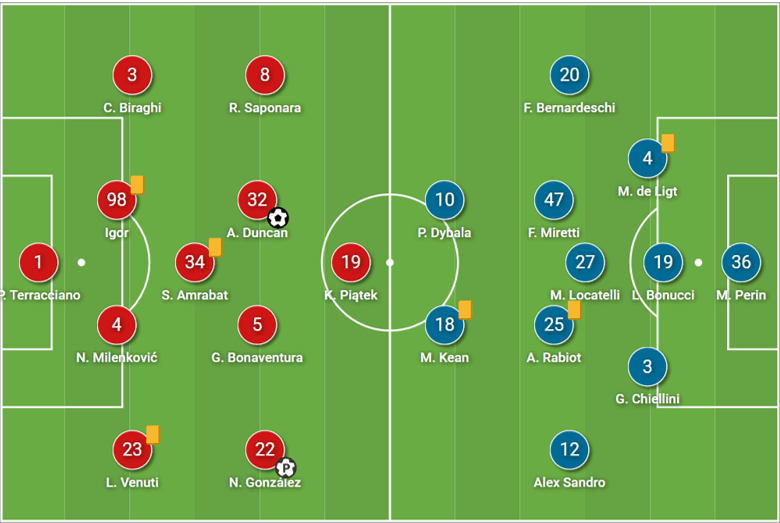
Hosts Fiorentina lined up in a 4-5-1 formation which looked to combat Juve’s midfield presence, ultimately forcing Juve to utilise wide areas which meant the wing-backs had to commit to attacks more. Pietro Terraciano kept goal, with help from a back four of Lorenzo Venuti, Nikola Milenković, Igor, and Cristiano Biraghi. Sofyan Amrabat offered defensive protection in midfield, while Giacomo Bonaventura and Alfred Duncan operated with more attacking presence in the engine room. Wide support came from Nicolás González and Riccardo Saponara, with Krzysztof Piątek leading the line.
Visitors Juventus came out in a 3-5-2 shape. Paulo Dybala played what is likely to be his final game in a Juve shirt, partnered up front with Moise Keane. Juve’s midfield consisted of Adrien Rabiot, Manuel Locatelli, and young star Fabio Miretti. Alex Sandro and Federico Bernadeschi operated as wing-backs in front of the back three.
Fiorentina’s ferocity out-of-possession
Perhaps the most impressive factor of Fiorentina’s performance in this fixture was the way they approached the game when out of possession. In short, it was simply a textbook example of discipline, hard work, and determination off the ball that Juventus had a nightmare dealing with.
In the image below, we see that even from the early stages the hosts were intent on giving Juve next to no time and space on the ball; achieved by committing a high number of players forward in a coordinated and well-timed tactical approach.
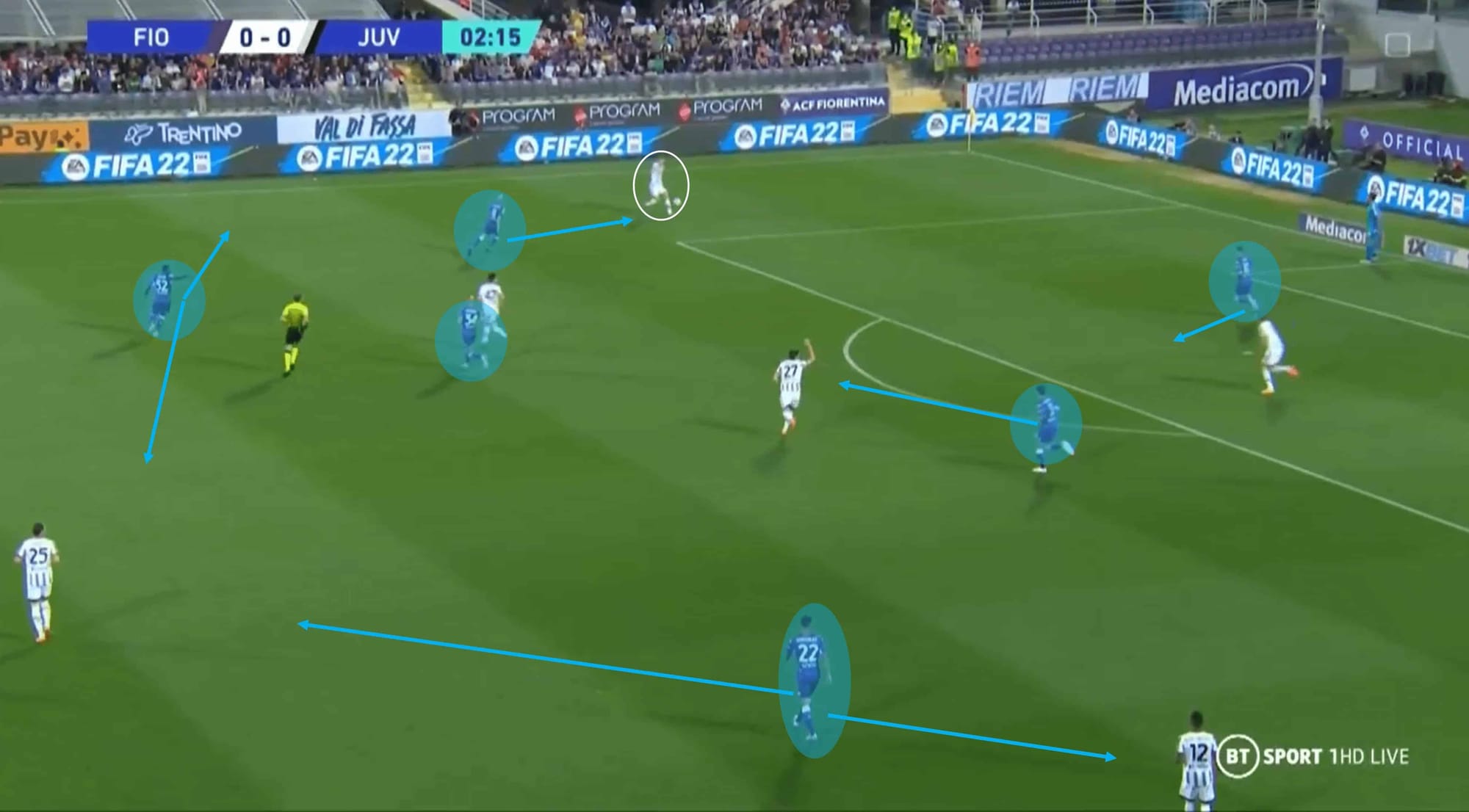
Juventus were clearly not prepared to deal with this threat as they approached the game in their usual style by trying to build through the thirds with fluidity – something they failed to achieve at all this time around. Fiorentina have six players in their attacking third during Juventus’ possession and showed high energy to force the visitors to act quickly on the ball. More often than not, that’s exactly what happened. Juve are not equipped to play in this way as the press forced them to hit long balls into the frontman with very little support. The home side won numerous turnovers in this way, which is a big contribution to Juve only registering 33% possession and 351 total passes.
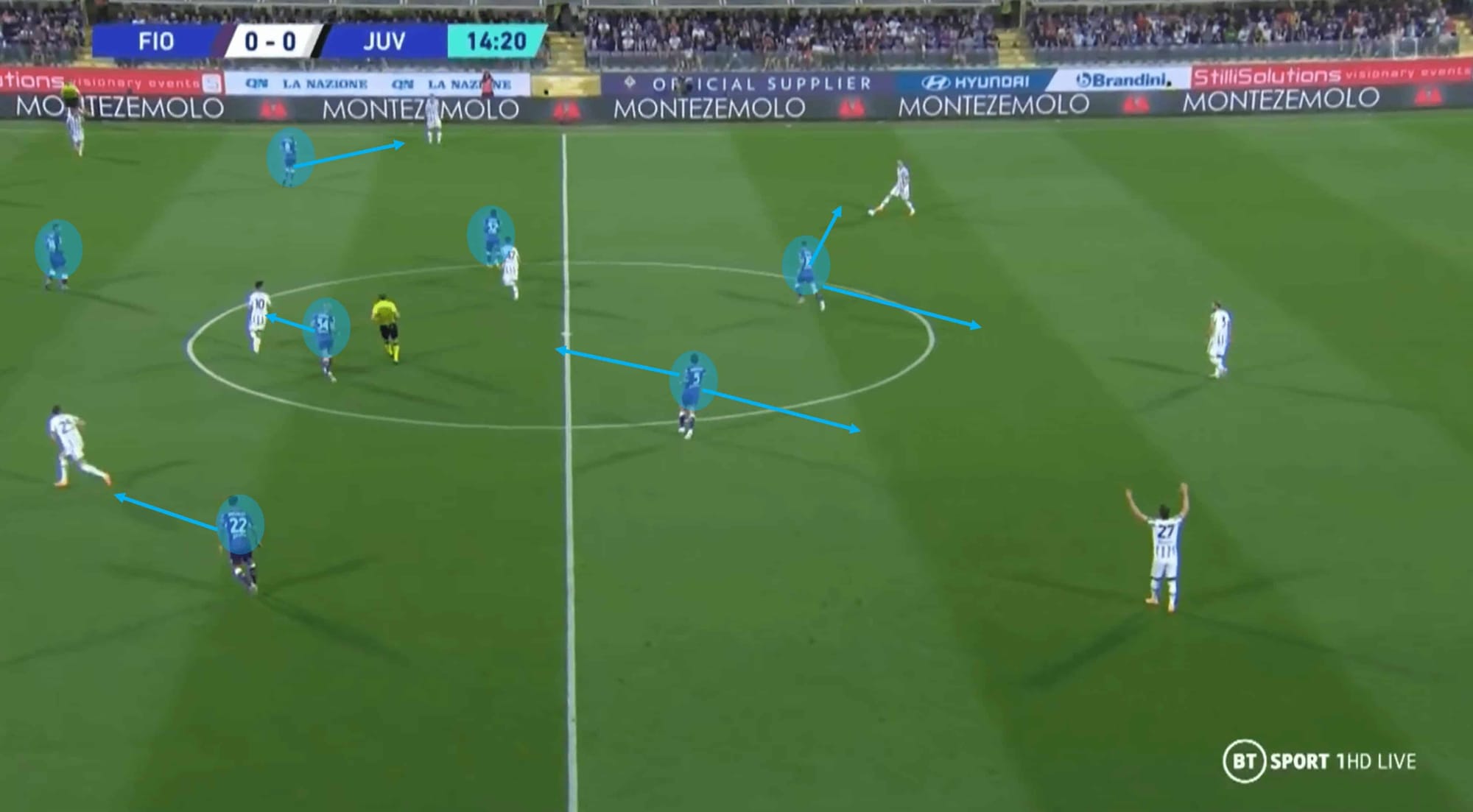
The image above shows more effective work being done out-of-possession by Fiorentina. While their press carries less aggression and intensity than the first example, the focus this time around is defensive organisation and positioning. With light pressure being applied to the Juve centre-back by Piątek, he can’t dwell on the ball too long and must progress possession. As we can see above, however, Fiorentina have tightly marked all of Juventus’ immediate options, with extra bodies in midfield to cover the spaces deeper than the initial midfield block.
The result of this? Juve would either chance a long ball with a low success rate or play a short pass to the closest wing-back but the pressure being put on him would force him to receive the ball facing his own goal and often with a poor first touch – both activating triggers for Fiorentina to inject that intensity and aggression into winning the ball back quickly.
Another interesting and clever element of this method is that Bonaventura pushed higher up to almost act as a strike partner to Piątek. This allowed for pendulum-esque motion if Juve were to switch possession to the opposite central defender where Bonaventura would apply pressure with Piątek providing the support.
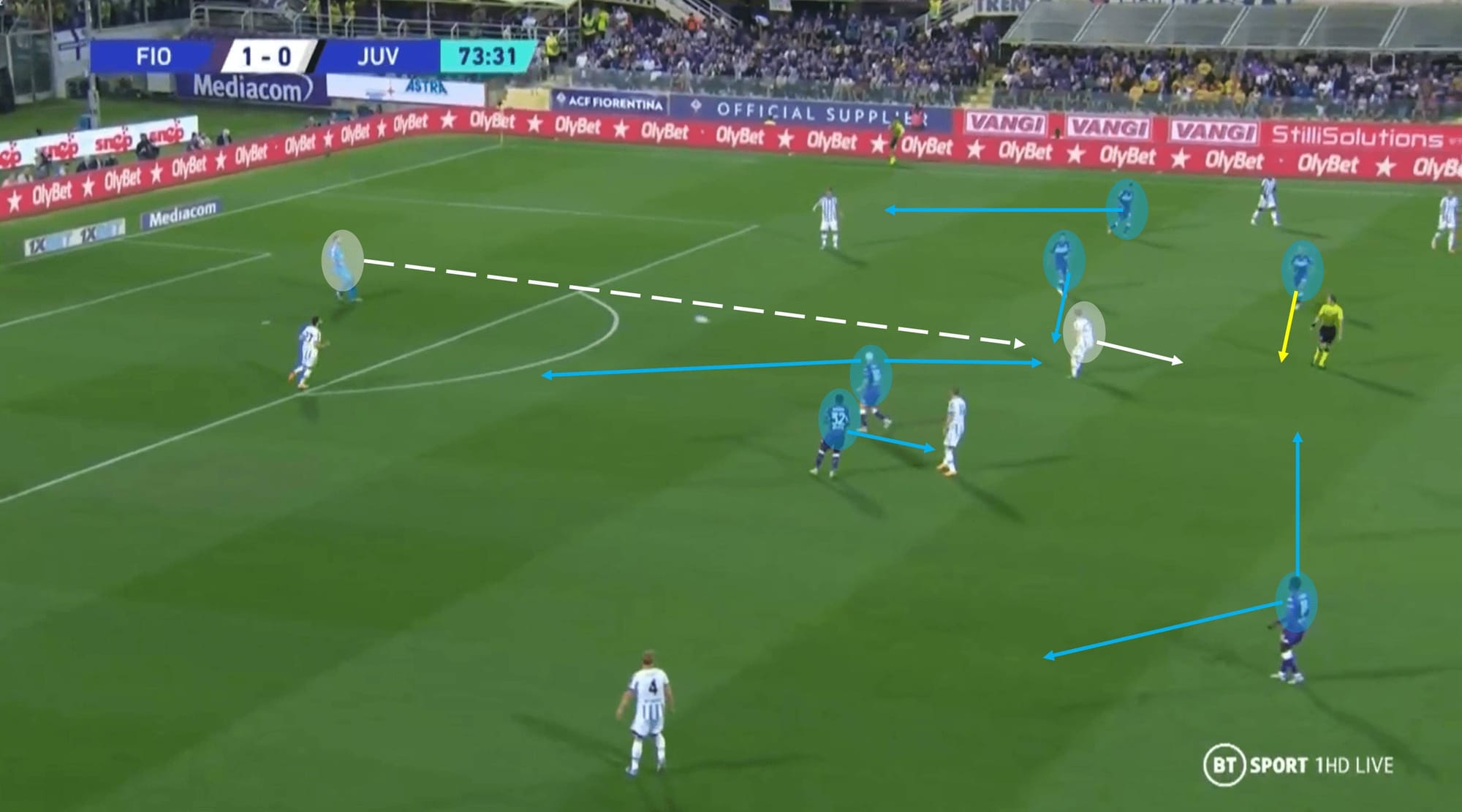
This final example shows how Fiorentina continued to perform cleverly off the ball, even in the latter stages of the match. Initial pressure forced a pass back to the goalkeeper, but Fiorentina didn’t entirely take their foot off the pedal – leaving bodies in high areas instead. The set-up above worked almost like a planned trap – two players on either side of the Juve CM with pressure applied at the right moment, with Amrabat lurking behind to make the challenge to win the ball, and Fiorentina could then attack still with good numbers in attacking areas. However, as the analysis above shows, they were prepared for alternative scenarios, with cover on standby in several areas.
Fiorentina playing in wide areas
Since the departure of Dušan Vlahović, Fiorentina have struggled to find a true source of regular goals, so they have leaned even further into focusing their possession and attacking approach in the wide areas. From overlapping full-backs to creating overloads to allow for combination play near the edge of the box, this is clearly the method of attack they feel is most dangerous for them with their current squad. While their approach play was effective on the whole, it missed a regular dangerous end product or simply star quality to get on the end of a cross.
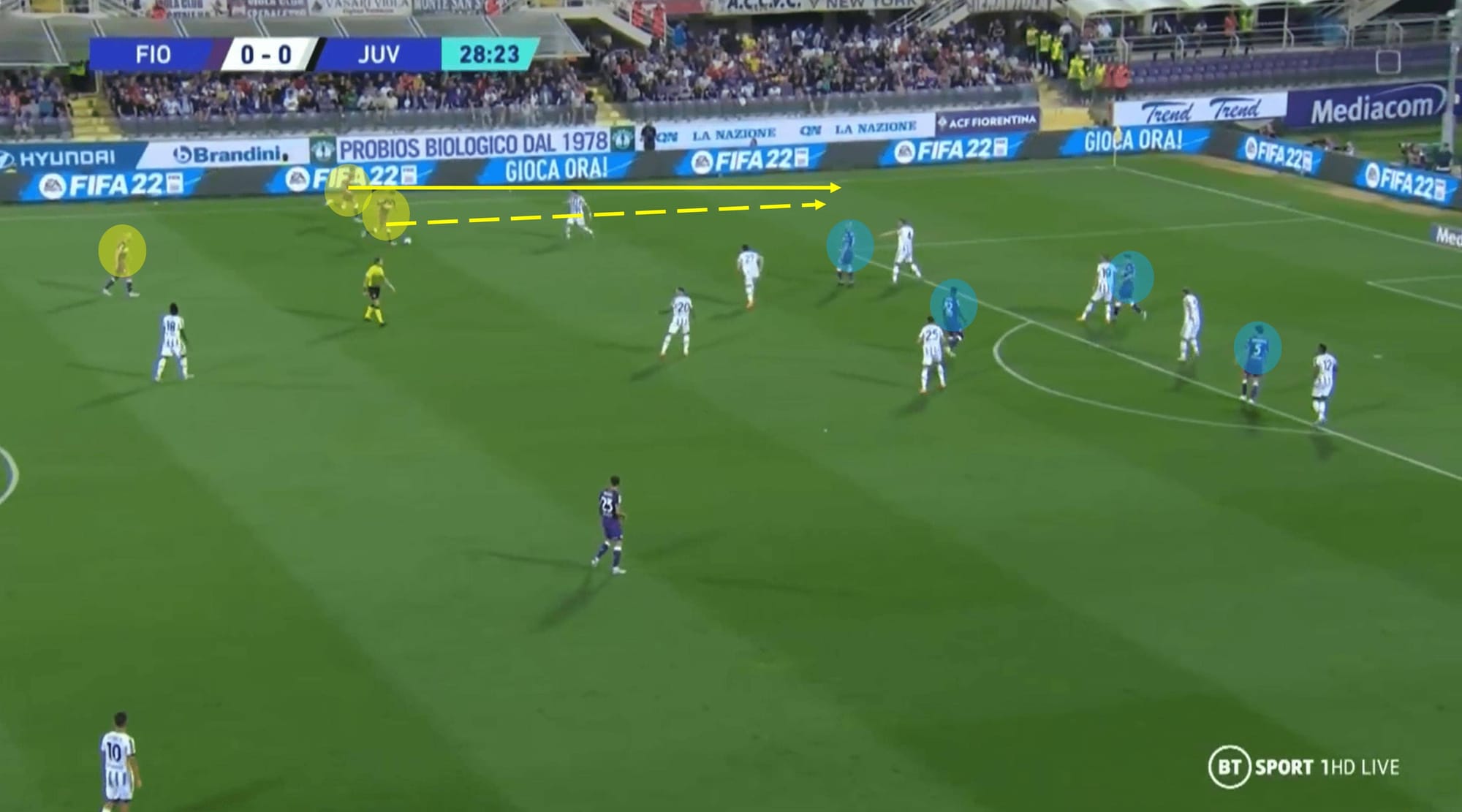
The first example shows a combination of both an overlapping full-back and some overloading with support being provided from midfield and attack. The immediate 2v1 overload on the far-left is not dealt with by Juve and the pass is played into Biraghi’s path who can drive with the ball towards the byline to find a cross.
But why did Juventus fail to deal with this approach? Well firstly, it wasn’t just Biraghi and Saponara on the far left who were involved – there was support from both deeper in midfield and from attackers near the edge of the box – both were options that Juve had to defend and couldn’t leave to chance. However, even with this considered, failure to provide defensive assistance with the 2v1 is poor and should not be happening, especially on numerous occasions. The potential was definitely there for Fiorentina to really hurt Juve in this fashion as well, as they always had a heavy presence in the box anticipating a delivery.
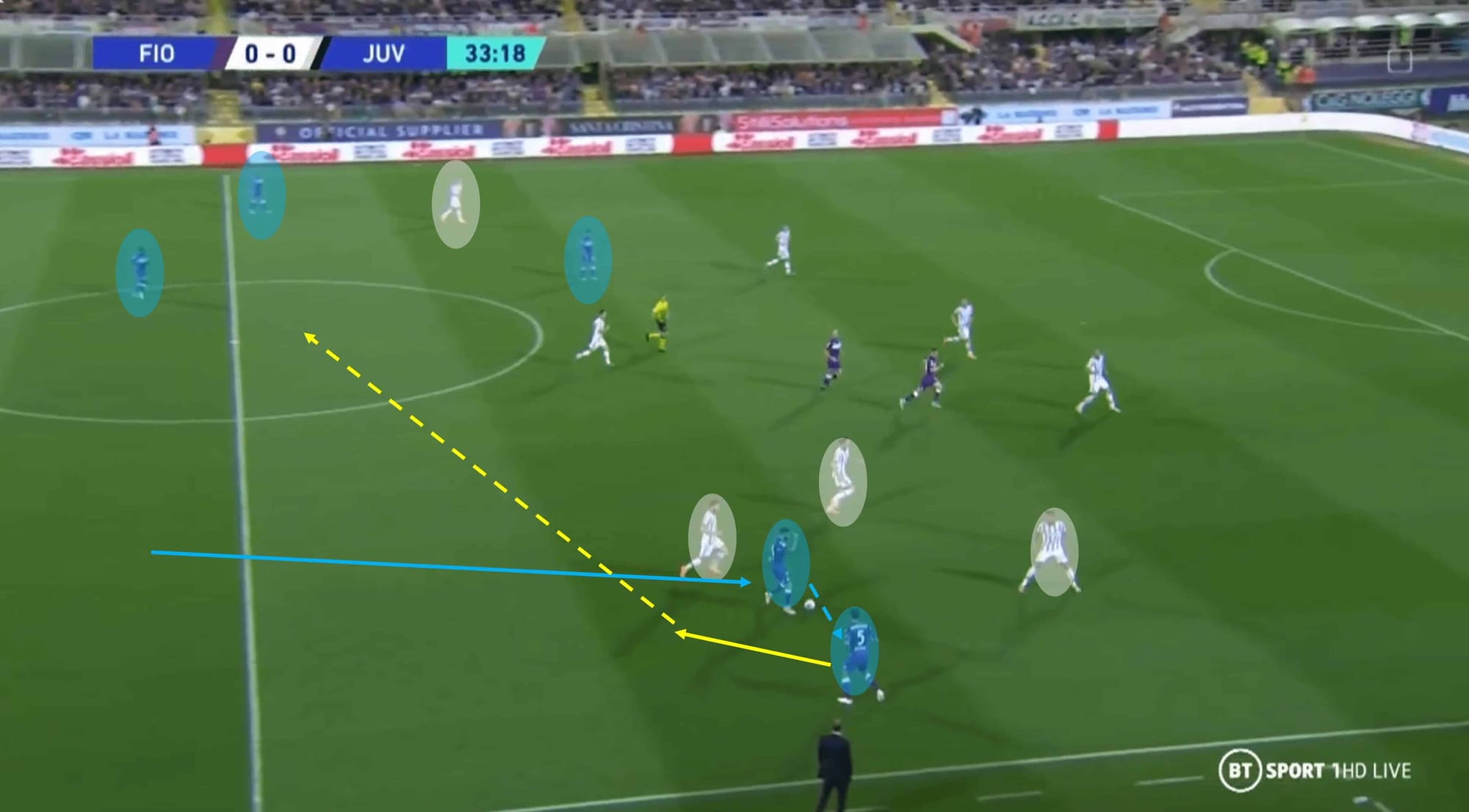
The analysis above provides an example of alternative uses of wide possession as Fiorentina used it almost like a decoy. Venuti drove forward with the ball from his own half into the position you see him in on the right flank, with Bonaventura providing close support. This move caused Juventus to try and surround the duo, with three black and white shirts looking to cut off their move down the flank. This only left space in the centre which Bonaventura was well-aware of, and played the ball into that zone shortly after receiving it. This allows Fiorentina to launch a fresh attack either on the opposite flank or straight through the centre – either were viable options as this decoy tactic caught the visitors off-guard and they were unorganised.
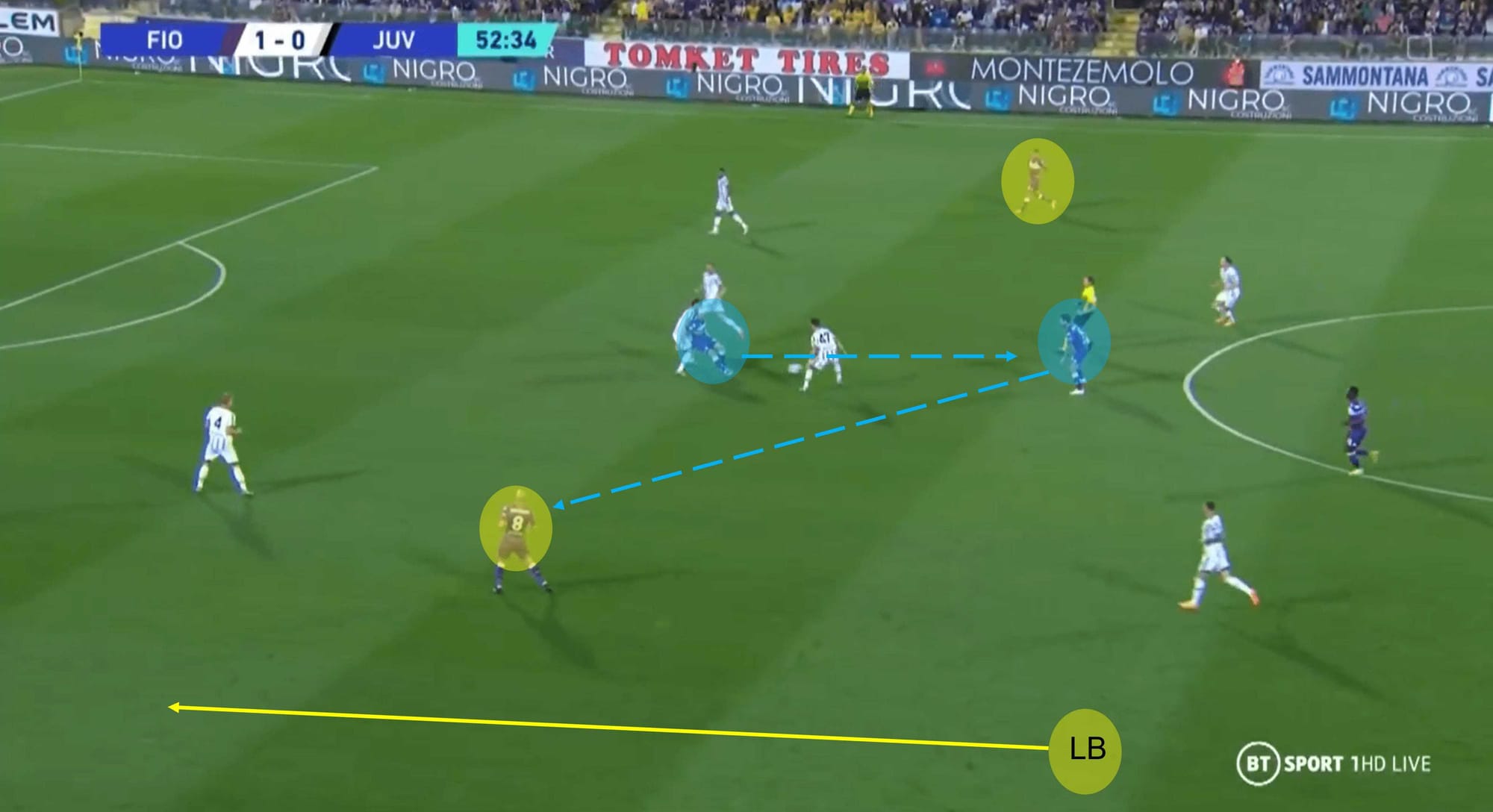
This final analysis example shows us Fiorentina deploying Krzysztof Piątek as a target man – something we saw only once or twice in this fixture but in reality, it’s an effective method of getting forward quickly. Again though, this tactic was not a fluke and you can tell just by looking at the supporting players. Bonaventura immediately backed up Piątek, available for the short pass once the striker has brought the ball under control.
Following that, options are open on either flank, Bonaventura just has the task of picking one and executing a crisp pass out there, and quickly. Notice how neither winger is hugging the touchline, however. This is to allow for the overlapping full-back once the winger receives the ball – this again will allow the hosts to create 2v1s on either flank and give them multiple methods of attack once they reach the box. As you can see from Juventus’ shape and presence, this move was a counter-attack, which only acts as more evidence of Fiorentina’s impeccable preparation.
Juve’s struggle in attack
We’ve touched upon Juventus’ lack of possession and low number of passes already – both of which limited their attacking opportunities. However, plenty of teams in the past have been dangerous on the ball even with low possession and passes. Juventus posed such little threat to the Fiorentina goal that they only registered one shot on goal, which was off target. While this emphasises Fiorentina’s success and hard work off the ball, it also highlights just how poor Juventus were on the ball and how they had no plan B to combat the tactics of the hosts.

Above is a rare example of the visitors reaching the Fiorentina box, but already they have pushed away slightly. There are two areas to highlight which stopped Juventus from progressing further than they did in the above example. The first is the compact shape of the back four, which gives Juventus very little space to execute passing combinations of any sort. Furthermore, Venuti at right-back is prepared for the switch pass and can close off the option quickly with some midfield support.
The second area is the energy and pressure from the midfield in the highlighted yellow zone. Fiorentina players are either rapidly sprinting in to apply pressure to the ball or immediate options, or quickly getting across to mark other Juve players. Even Krzysztof Piątek committed himself to defensive duties to allow Fiorentina to completely surround Juventus and choke this attack out. From a Juventus perspective, a failure to move the ball quickly enough and a lack of creative thinking – both with passing and with movement – were also going to make it difficult to create any dangerous opportunities.
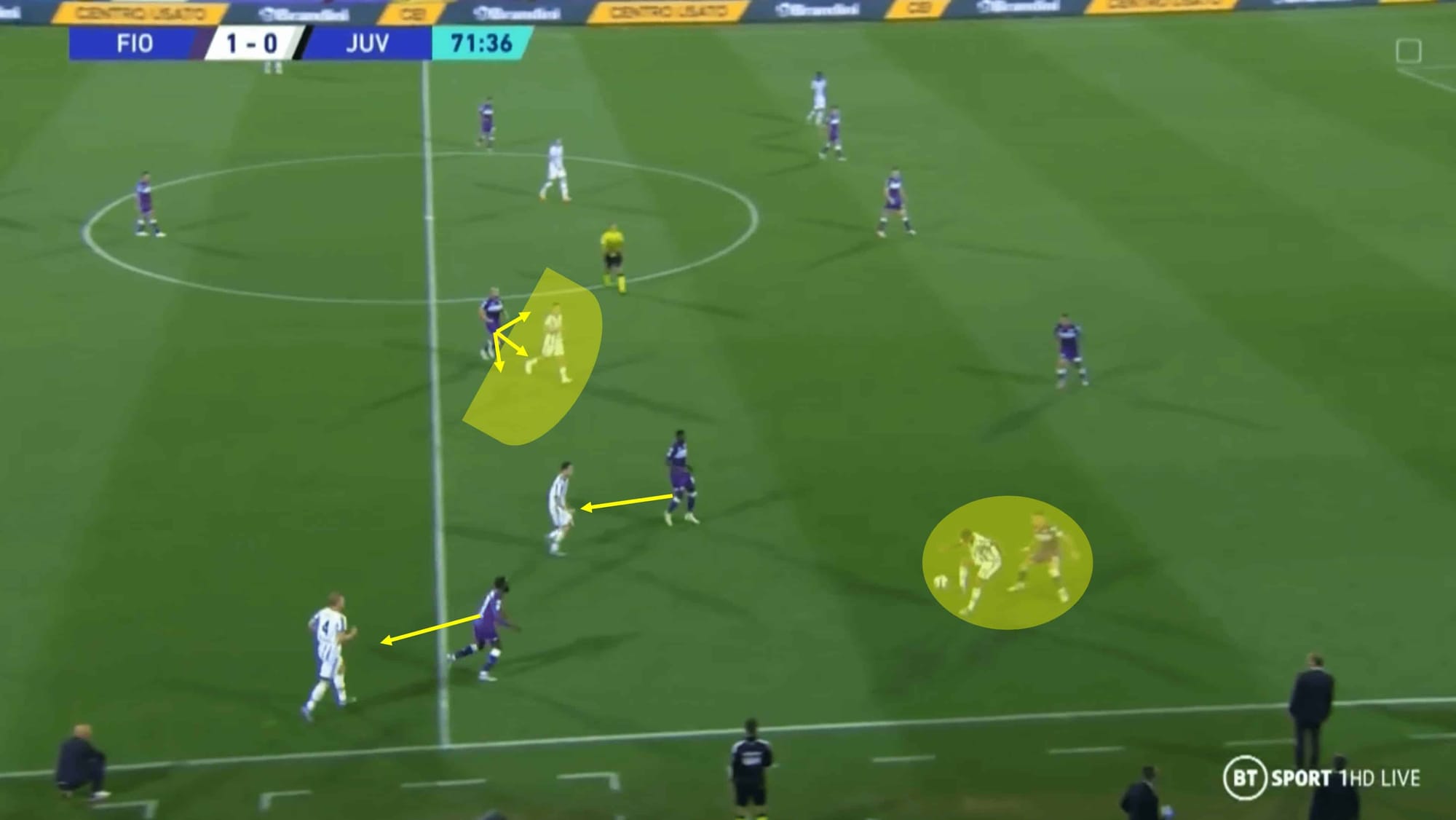
This final analysis shows Juventus looking to catch Fiorentina out with a long, floated pass into the right flank in an attempt to bypass the midfield press. For a number of reasons, this failed and now we will explore the key factors. From a defensive point of view, this is superb work from Fiorentina – there are just three Juventus players in close proximity following the counter-attack attempt, but Fiorentina are still on hand to tightly mark each player, giving Dybala the slightest of chances of turning this move into anything even remotely successful.
But the issue is with Juventus’ reaction to the approach, rather than the approach itself. 70+ minutes have gone in the game and Juventus should be well aware of the Fiorentina press now – the long ball/counter-attack approach initially suggests that they can combat that press. However, the sheer lack of urgency and attacking hunger from Juventus tells a different story. Not only are there not any players ready and waiting as the ball arrives with Dybala but there are also no players making a run beyond the ball, which only helps Fiorentina choke this attack out as everything is in one direction and at the same angle.
Conclusion
There are bad days at the office, and then there’s this Juventus performance. It lacked creativity, motivation, adaptability, and energy. Maybe this is down to them already being secure in fourth place in the league and therefore this fixture had no mathematical importance in terms of the league itself. However, there was hardly even a sense of pride in the performance; no sense of wanting to finish the season on a high or send the travelling fans home with something to smile about.
Something of a rebuild could be on the cards for the club, especially with Dybala seemingly on his way out in the summer. Fiorentina will be delighted with the result, but even more delighted with the manner of it. In this fixture, they were the exact opposite of Juventus. They were clever, creative, played with passion, and showed a real understanding and respect for the manager’s tactics. Each player and unit carried out their responsibilities brilliantly which is why they made Juventus look very average.

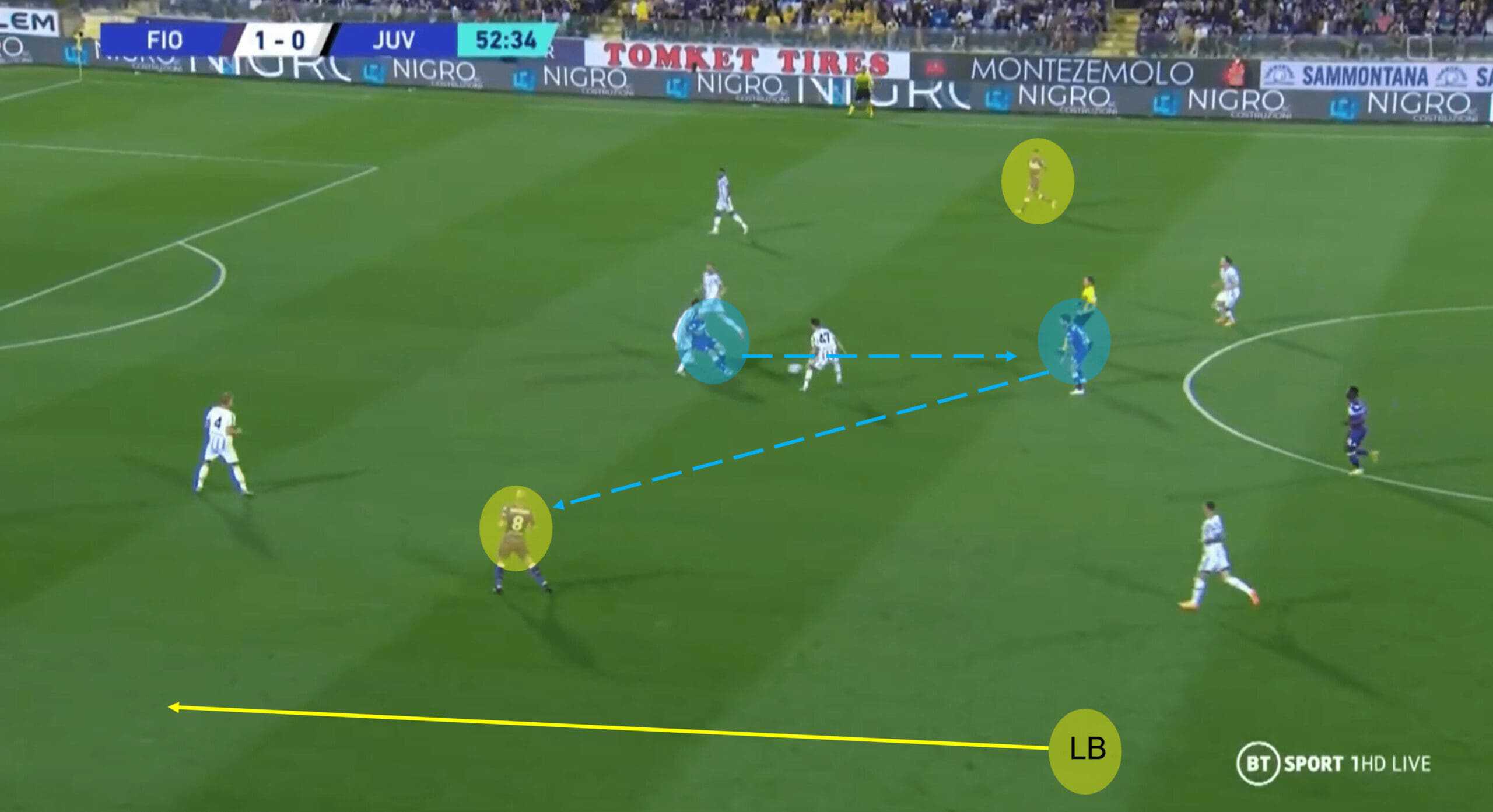




Comments